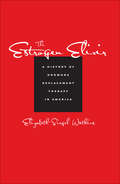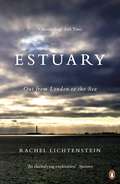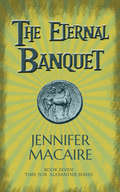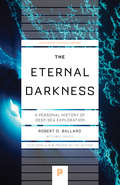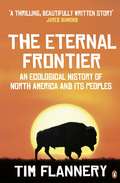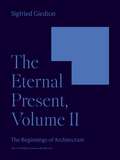- Table View
- List View
Estranging the Novel: Poland, Ireland, and Theories of World Literature
by Katarzyna BartoszynskaTo develop a theory of world literature, this book demands that the theory of the novel can no longer ignore literary forms other than realism.For centuries, the standard account of the development of the novel focused on the rise of realism in English literature. Studies of early novels connected the form to various aspects of British life across the eighteenth and nineteenth centuries, including the burgeoning middle class, the growth of individualism, and the emergence of democracy and the nation-state. But as the push for teaching and learning global literature grows, this narrative is insufficient for studying novel forms outside of a predominately English-speaking British and American realm.In Estranging the Novel, Katarzyna Bartoszynska explores how the emergence and growth of world literature studies has challenged the centrality of British fiction to theories of the novel's rise. She argues that a historicist approach frequently reinforces the realist paradigm that has cast other traditions as "minor," conceding a normative vision of the novel as it seeks to explain why historical forces produced different forms elsewhere. Recasting the standard narrative by looking at different novelistic literary forms, including the Gothic, travel writing, and queer fiction, Bartoszynska offers a compelling comparative study of Polish and Irish works published across the long nineteenth century that emphasize fictionality, or the problem of world-building in literature.Reading works by Ignacy Krasicki, Jan Potocki, Narcyza Zmichowska, and Witold Gombrowicz alongside others by Jonathan Swift, Charles Maturin, Oscar Wilde, and Samuel Beckett, Bartoszynska shows that the history of the novel's rise demands a more capacious and rigorous approach to form as well as a reconceptualization of the relationship between fiction and its cultural contexts. By modeling such a heterogeneous account of the novel form, Estranging the Novel paves the way for a bracing and diverse understanding of the makeup of contemporary world literature and the many texts it encompasses—and a new perspective on the British novel as well.
Estranging the Novel: Poland, Ireland, and Theories of World Literature
by Katarzyna BartoszynskaTo develop a theory of world literature, this book demands that the theory of the novel can no longer ignore literary forms other than realism.For centuries, the standard account of the development of the novel focused on the rise of realism in English literature. Studies of early novels connected the form to various aspects of British life across the eighteenth and nineteenth centuries, including the burgeoning middle class, the growth of individualism, and the emergence of democracy and the nation-state. But as the push for teaching and learning global literature grows, this narrative is insufficient for studying novel forms outside of a predominately English-speaking British and American realm.In Estranging the Novel, Katarzyna Bartoszynska explores how the emergence and growth of world literature studies has challenged the centrality of British fiction to theories of the novel's rise. She argues that a historicist approach frequently reinforces the realist paradigm that has cast other traditions as "minor," conceding a normative vision of the novel as it seeks to explain why historical forces produced different forms elsewhere. Recasting the standard narrative by looking at different novelistic literary forms, including the Gothic, travel writing, and queer fiction, Bartoszynska offers a compelling comparative study of Polish and Irish works published across the long nineteenth century that emphasize fictionality, or the problem of world-building in literature.Reading works by Ignacy Krasicki, Jan Potocki, Narcyza Zmichowska, and Witold Gombrowicz alongside others by Jonathan Swift, Charles Maturin, Oscar Wilde, and Samuel Beckett, Bartoszynska shows that the history of the novel's rise demands a more capacious and rigorous approach to form as well as a reconceptualization of the relationship between fiction and its cultural contexts. By modeling such a heterogeneous account of the novel form, Estranging the Novel paves the way for a bracing and diverse understanding of the makeup of contemporary world literature and the many texts it encompasses—and a new perspective on the British novel as well.
The Estrogen Elixir: A History of Hormone Replacement Therapy in America
by Elizabeth Siegel WatkinsIn the first complete history of hormone replacement therapy (HRT), Elizabeth Siegel Watkins illuminates the complex and changing relationship between the medical treatment of menopause and cultural conceptions of aging. Describing the development, spread, and shifting role of HRT in America from the early twentieth century to the present, Watkins explores how the interplay between science and society shaped the dissemination and reception of HRT and how the medicalization—and subsequent efforts toward the demedicalization—of menopause and aging affected the role of estrogen as a medical therapy. Telling the story from multiple perspectives—physicians, pharmaceutical manufacturers, government regulators, feminist health activists, and the media, as well as women as patients and consumers—she reveals the striking parallels between estrogen’s history as a medical therapy and broad shifts in the role of medicine in an aging society.Today, information about HRT is almost always accompanied by a laundry list of health risks. While physicians and pharmaceutical companies have striven to develop the safest possible treatment for the symptoms of menopause and aging, many specialists question whether HRT should be prescribed at all. Drawing from a wide range of scholarly research, archival records, and interviews, The Estrogen Elixir provides valuable historical context for one of the most pressing debates in contemporary medicine.
Estuary: Out from London to the Sea
by Rachel LichtensteinLONGLISTED FOR THE GORDON BURN PRIZE 2017An immersive, intimate journey into the world of the Thames Estuary and the people who spend their lives thereThe Thames Estuary is one of the world's great deltas, providing passage in and out of London for millennia. It is silted up with the memories and artefacts of past voyages. It is the habitat for an astonishing range of wildlife. And for the people who live and work on the estuary, it is a way of life unlike any other - one most would not trade for anything, despites its dangers.Rachel Lichtenstein has travelled the length and breadth of the estuary many times and in many vessels, from hardy tug boats to stately pleasure cruisers to an inflatable dinghy. And during these crossing she has gathered an extraordinary chorus of voices: mudlarkers and fishermen, radio pirates and champion racers, the men who risk their lives out on the water and the women who wait on the shore.From the acclaimed author of Brick Lane and Rodinsky's Room, Estuary is a thoughtful and intimate portrait of a profoundly British place. With a clear eye and a sharp ear, Rachel Lichtenstein captures the essence of a community and an environment, examining how each has shaped and continues to shape the other.
Eternal
by Lisa ScottolineWhat war destroys, only love can heal.Elisabetta, Marco, and Sandro grow up as the best of friends despite their differences. Elisabetta is a feisty beauty who dreams of becoming a novelist; Marco the brash and athletic son in a family of professional cyclists; and Sandro a Jewish mathematics prodigy, kind-hearted and thoughtful, the son of a lawyer and a doctor. Their friendship blossoms to love, with both Sandro and Marco hoping to win Elisabetta's heart. But in the autumn of 1937, all of that begins to change as Mussolini asserts his power, aligning Italy's Fascists with Hitler's Nazis and altering the very laws that govern Rome. In time, everything that the three hold dear - their families, their homes, and their connection to one another--is tested in ways they never could have imagined.As anti-Semitism takes legal root and World War II erupts, the threesome realizes that Mussolini was only the beginning. The Nazis invade Rome, and with their occupation come new atrocities against the city's Jews, culminating in a final, horrific betrayal. Against this backdrop, the intertwined fates of Elisabetta, Marco, Sandro, and their families will be decided, in a heartbreaking story of both the best and the worst that the world has to offer.Unfolding over decades, Eternal is a tale of loyalty and loss, family and food, love and war - all set in one of the world's most beautiful cities at its darkest moment. This moving novel will be forever etched in the hearts and minds of readers.'An accomplished historical novel that is both steeped in period detail and full of relatable characters.... Scottoline is a master at ramping up the suspense' - WASHINGTON POST'In this book of her heart, Lisa Scottoline delivers what her readers expect and so much more, fast-paced intrigue, but also an authentic, tender coming of age tale of three best friends navigating the complexities of fascism, war, political and family strife and romantic competition' - LISA WINGATE
The Eternal Banquet: The Time for Alexander Series (The Time for Alexander Series #7)
by Jennifer MacaireIn the final book in the Time for Alexander series, Ashley and Alexander journey to Carthage, seal the fate of Rome, take part in the game of Phersu, meet a demon, and wrap up the series in a fine style indeed!On their way back to Egypt, Alexander and Ashley stop in Carthage where they save a boy intended for a bloody sacrifice. Fleeing Carthage's warships, they take refuge in Rome where Alexander is recognised, captured, and forced to take part in the terrifying 'Game of Phersu' in the arena. No doubt having Alexander the Great as a gladiator will draw the crowds...but can it mean the end of his adventures? It's too late for regrets. Time, as Alexander and Ashley discover, marches on – whether or not you cheat the fates.
Eternal Chalice: The Enduring Legend of the Holy Grail
by Juliette WoodWhat is the secret of the Grail?' So intoned a heavenly voice to Sir Percival in John Boorman's stylish and influential film 'Excalibur' (1981). The sacred allure of the Holy Grail has fascinated writers and ensnared knights for over a thousand years. From Malory to Monty Python, the eternal chalice - said to be the very cup from which Christ drank at the Last Supper - has the richest associations of any icon in British myth. Many different meanings have been devised for the Grail, which has been linked to the Celts and King Arthur, the eucharistic rites of Eastern Christianity, ancient mystery religions, Jungian archetypes, dualist heresies, Templar treasure and even the alleged descendants of Christ himself and Mary Magdalene. The common thread running through all these stories is the assumption that the Grail legend has a single source with a meaning that - if only we could decode it - is concealed in the romances themselves. That meaning has become the subject of coded, secret documents and is the central feature of a vast conspiracy supposedly stretching back to the dawn of western civilization.Juliette Wood here reveals the elusive and embedded significance of the Grail story in popular consciousness - as myth, medieval romance, tangible holy relic and finally as the centre of an esoteric theory of global conspiracy. The author shows how various interpretations of the Grail, over the centuries, reflect changing cultural needs and desires. Her book will enthral those who, like Sir Percival, seek to unlock the mysterious secrets of western mythology's most extraordinary and tantalising enigma, and will delight students of history, myth and religion alike.
The Eternal City: Roman Images in the Modern World
by Peter BondanellaA major new interpretation of the impact of ancient Rome on our culture, this study charts the effects of two diametrically opposed views of Roman antiquity: the virtuous republic of self-less citizen soldiers and the corrupt empire of power-hungry tyrants. The power of these images is second only to those derived from Christianity in constructing our modern culture. Few modern readers are aware of how indebted we are to the Roman model of our political philosophy, art, music, cinema, opera, and drama. Originally published in 1987.A UNC Press Enduring Edition -- UNC Press Enduring Editions use the latest in digital technology to make available again books from our distinguished backlist that were previously out of print. These editions are published unaltered from the original, and are presented in affordable paperback formats, bringing readers both historical and cultural value.
The Eternal City: A History of Rome in Maps
by Jessica MaierOne of the most visited places in the world, Rome attracts millions of tourists each year to walk its storied streets and see famous sites like the Colosseum, St. Peter’s Basilica, and the Trevi Fountain. Yet this ancient city’s allure is due as much to its rich, unbroken history as to its extraordinary array of landmarks. Countless incarnations and eras merge in the Roman cityscape. With a history spanning nearly three millennia, no other place can quite match the resilience and reinventions of the aptly nicknamed Eternal City. In this unique and visually engaging book, Jessica Maier considers Rome through the eyes of mapmakers and artists who have managed to capture something of its essence over the centuries. Viewing the city as not one but ten “Romes,” she explores how the varying maps and art reflect each era’s key themes. Ranging from modest to magnificent, the images comprise singular aesthetic monuments like paintings and grand prints as well as more popular and practical items like mass-produced tourist plans, archaeological surveys, and digitizations. The most iconic and important images of the city appear alongside relatively obscure, unassuming items that have just as much to teach us about Rome’s past. Through 140 full-color images and thoughtful overviews of each era, Maier provides an accessible, comprehensive look at Rome’s many overlapping layers of history in this landmark volume. The first English-language book to tell Rome’s rich story through its maps, The Eternal City beautifully captures the past, present, and future of one of the most famous and enduring places on the planet.
The Eternal City: A History of Rome in Maps
by Jessica MaierOne of the most visited places in the world, Rome attracts millions of tourists each year to walk its storied streets and see famous sites like the Colosseum, St. Peter’s Basilica, and the Trevi Fountain. Yet this ancient city’s allure is due as much to its rich, unbroken history as to its extraordinary array of landmarks. Countless incarnations and eras merge in the Roman cityscape. With a history spanning nearly three millennia, no other place can quite match the resilience and reinventions of the aptly nicknamed Eternal City. In this unique and visually engaging book, Jessica Maier considers Rome through the eyes of mapmakers and artists who have managed to capture something of its essence over the centuries. Viewing the city as not one but ten “Romes,” she explores how the varying maps and art reflect each era’s key themes. Ranging from modest to magnificent, the images comprise singular aesthetic monuments like paintings and grand prints as well as more popular and practical items like mass-produced tourist plans, archaeological surveys, and digitizations. The most iconic and important images of the city appear alongside relatively obscure, unassuming items that have just as much to teach us about Rome’s past. Through 140 full-color images and thoughtful overviews of each era, Maier provides an accessible, comprehensive look at Rome’s many overlapping layers of history in this landmark volume. The first English-language book to tell Rome’s rich story through its maps, The Eternal City beautifully captures the past, present, and future of one of the most famous and enduring places on the planet.
The Eternal Darkness: A Personal History of Deep-Sea Exploration
by Robert D. Ballard Will HivelyUntil a few decades ago, the ocean depths were almost as mysterious and inaccessible as outer space. Oceans cover two-thirds of the earth's surface with an average depth of more than two miles--yet humans had never ventured more than a few hundred feet below the waves. One of the great scientific and archaeological feats of our time has been finally to cast light on the "eternal darkness" of the deep sea. This is the story of that achievement, told by the man who has done more than any other to make it possible: Robert Ballard. Ballard discovered the wreck of the Titanic. He led the teams that discovered hydrothermal vents and "black smokers"--cracks in the ocean floor where springs of superheated water support some of the strangest life-forms on the planet. He was a diver on the team that explored the mid-Atlantic ridge for the first time, confirming the theory of plate tectonics. Today, using a nuclear submarine from the U.S. Navy, he's exploring the ancient trade routes of the Mediterranean and the Black Sea for the remains of historic vessels and their cargo. In this book, he combines science, history, spectacular illustrations, and first-hand stories from his own expeditions in a uniquely personal account of how twentieth-century explorers have pushed back the frontiers of technology to take us into the midst of a world we could once only guess at. Ballard begins in 1930 with William Beebe and Otis Barton, pioneers of the ocean depths who made the world's first deep-sea dives in a cramped steel sphere. He introduces us to Auguste and Jacques Piccard, whose "Bathyscaph"descended in 1960 to the lowest point on the ocean floor. He reviews the celebrated advances made by Jacques Cousteau. He describes his own major discoveries--from sea-floor spreading to black smokers--as well as his technical breakthroughs, including the development of remote-operated underwater vehicles and the revolutionary search techniques that led to the discovery and exploration of the Titanic, the Nazi battleship Bismarck, ancient trading vessels, and other great ships. Readers will come away with a richer understanding of history, earth science, biology, and marine technology--and a new appreciation for the remarkable men and women who have explored some of the most remote and fascinating places on the planet.
Eternal Dawn: Turkey in the Age of Atatürk
by Ryan GingerasAmid the tensions and uncertainties that plagued the globe before the Second World War, the Republic of Turkey appeared to many as a unique and constructive model for how a state was to be reformed and governed in the modern era. For many interwar observers, Turkey was a country that seemed to have radically transformed itself into a nation that was united, strong, and progressive, one that was unburdened by its past. A general consensus held that Turkey's founding president, Mustafa Kemal Atatürk, was the chief architect and engineer of this feat, a belief that placed him among the greatest reforming statesmen in world history. This general perception of Atatürk and his revolutionary rule has largely endured to this day. As a study grounded in largely untapped archival and scholarly sources, Eternal Dawn presents a definitive look inside the development and evolution of Atatürk's Turkey. Rather than presenting the country's founding and transformation as an extension of Mustafa Kemal's life and achievements, scholar Ryan Gingeras presents Turkey's early years as the culmination of a variety of social and political forces dating back to the late Ottoman Empire. Eternal Dawn presses beyond the reigning mythology that still envelops this period and challenges many of the standing assumptions about the limits, successes, and consequences of the reforms that comprised Mustafa Kemal's revolution. Through a detailed survey of social and political conditions that defined life in the capital as well as Turkey's diverse provinces, Gingeras lays bare many of the harsh realities and bitter legacies incurred as a result of the republic's establishment and transformation. Atatürk's revolution, upon final analysis, destroyed as much as it built, and established precedents that both strengthen and torment the country to this day.
Eternal Dawn: Turkey in the Age of Atatürk
by Ryan GingerasAmid the tensions and uncertainties that plagued the globe before the Second World War, the Republic of Turkey appeared to many as a unique and constructive model for how a state was to be reformed and governed in the modern era. For many interwar observers, Turkey was a country that seemed to have radically transformed itself into a nation that was united, strong, and progressive, one that was unburdened by its past. A general consensus held that Turkey's founding president, Mustafa Kemal Atatürk, was the chief architect and engineer of this feat, a belief that placed him among the greatest reforming statesmen in world history. This general perception of Atatürk and his revolutionary rule has largely endured to this day. As a study grounded in largely untapped archival and scholarly sources, Eternal Dawn presents a definitive look inside the development and evolution of Atatürk's Turkey. Rather than presenting the country's founding and transformation as an extension of Mustafa Kemal's life and achievements, scholar Ryan Gingeras presents Turkey's early years as the culmination of a variety of social and political forces dating back to the late Ottoman Empire. Eternal Dawn presses beyond the reigning mythology that still envelops this period and challenges many of the standing assumptions about the limits, successes, and consequences of the reforms that comprised Mustafa Kemal's revolution. Through a detailed survey of social and political conditions that defined life in the capital as well as Turkey's diverse provinces, Gingeras lays bare many of the harsh realities and bitter legacies incurred as a result of the republic's establishment and transformation. Atatürk's revolution, upon final analysis, destroyed as much as it built, and established precedents that both strengthen and torment the country to this day.
The Eternal Decline and Fall of Rome: The History of a Dangerous Idea
by Edward J. WattsAs this book intriguingly explores, for those who would make Rome great again and their victims, ideas of Roman decline and renewal have had a long and violent history. The decline of Rome has been a constant source of discussion for more than 2200 years. Everyone from American journalists in the twenty-first century AD to Roman politicians at the turn of the third century BC have used it as a tool to illustrate the negative consequences of changes in their world. Because Roman history is so long, it provides a buffet of ready-made stories of decline that can help develop the context around any snapshot. And Rome did, in fact, decline and, eventually, fall. An empire that once controlled all or part of more than 40 modern European, Asian, and African countries no longer exists. Roman prophets of decline were, ultimately, proven correct-a fact that makes their modern invocations all the more powerful. If it happened then, it could happen now. The Eternal Decline and Fall of Rome tells the stories of the people who built their political and literary careers around promises of Roman renewal as well as those of the victims they blamed for causing Rome's decline. Each chapter offers the historical context necessary to understand a moment or a series of moments in which Romans, aspiring Romans, and non--Romans used ideas of Roman decline and restoration to seize power and remake the world around them. The story begins during the Roman Republic just after 200 BC. It proceeds through the empire of Augustus and his successors, traces the Roman loss of much of western Europe in the fifth century AD, and then follows Roman history as it runs through the Eastern Roman Empire (Byzantium) until its fall in 1453. The final two chapters look at ideas of Roman decline and renewal from the fifteenth century until today. If Rome illustrates the profound danger of the rhetoric of decline, it also demonstrates the rehabilitative potential of a rhetoric that focuses on collaborative restoration, a lesson of great relevance to our world today.
The Eternal Decline and Fall of Rome: The History of a Dangerous Idea
by Edward J. WattsAs this book intriguingly explores, for those who would make Rome great again and their victims, ideas of Roman decline and renewal have had a long and violent history. The decline of Rome has been a constant source of discussion for more than 2200 years. Everyone from American journalists in the twenty-first century AD to Roman politicians at the turn of the third century BC have used it as a tool to illustrate the negative consequences of changes in their world. Because Roman history is so long, it provides a buffet of ready-made stories of decline that can help develop the context around any snapshot. And Rome did, in fact, decline and, eventually, fall. An empire that once controlled all or part of more than 40 modern European, Asian, and African countries no longer exists. Roman prophets of decline were, ultimately, proven correct-a fact that makes their modern invocations all the more powerful. If it happened then, it could happen now. The Eternal Decline and Fall of Rome tells the stories of the people who built their political and literary careers around promises of Roman renewal as well as those of the victims they blamed for causing Rome's decline. Each chapter offers the historical context necessary to understand a moment or a series of moments in which Romans, aspiring Romans, and non--Romans used ideas of Roman decline and restoration to seize power and remake the world around them. The story begins during the Roman Republic just after 200 BC. It proceeds through the empire of Augustus and his successors, traces the Roman loss of much of western Europe in the fifth century AD, and then follows Roman history as it runs through the Eastern Roman Empire (Byzantium) until its fall in 1453. The final two chapters look at ideas of Roman decline and renewal from the fifteenth century until today. If Rome illustrates the profound danger of the rhetoric of decline, it also demonstrates the rehabilitative potential of a rhetoric that focuses on collaborative restoration, a lesson of great relevance to our world today.
The Eternal Frontier: An Ecological History Of North America And Its Peoples
by Tim FlanneryThe Eternal Frontier leads the reader on a 65-million-year quest to understand the formation of North America. From the asteroid impact that wiped out the dinosaurs at the end of the Cretaceous Period to the present day, Flannery explores America's history with keen insight and an extraordinary breadth of knowledge. Ultimately, human beings had to face the environmental vicissitudes of the continent, and Flannery's exploration of the ways in which we have coped makes for fascinating reading.
Eternal Iran: Continuity and Chaos (Middle East in Focus)
by P. Clawson M. RubinExploring continuities and changes, this book provides the historical backdrop crucial to understanding how Iranian pride and sense of victimization combine to make its politics contentious and potentially dangerous.
Eternal light and earthly concerns: Belief and the shaping of medieval society (Artes Liberales Ser.)
by Paul FouracreIn early Christianity it was established that every church should have a light burning on the altar at all times. In this unique study, Eternal light and earthly concerns, looks at the material and social consequences of maintaining these ‘eternal’ lights. It investigates how the cost of lighting was met across western Europe throughout the whole of the Middle Ages, revealing the social organisation that was built up around maintaining the lights in the belief that burning them reduced the time spent in Purgatory. When that belief collapsed in the Reformation the eternal lights were summarily extinguished. The history of the lights thus offers not only a new account of change in medieval Europe, but also a sustained examination of the relationship between materiality and belief.
Eternal light and earthly concerns: Belief and the shaping of medieval society
by Paul FouracreIn early Christianity it was established that every church should have a light burning on the altar at all times. In this unique study, Eternal light and earthly concerns, looks at the material and social consequences of maintaining these ‘eternal’ lights. It investigates how the cost of lighting was met across western Europe throughout the whole of the Middle Ages, revealing the social organisation that was built up around maintaining the lights in the belief that burning them reduced the time spent in Purgatory. When that belief collapsed in the Reformation the eternal lights were summarily extinguished. The history of the lights thus offers not only a new account of change in medieval Europe, but also a sustained examination of the relationship between materiality and belief.
Eternal People: A Novel
by David MilofskyEternal People,/i> tells the story of Joseph Abrams, a Ukrainian Jew who finds his way to America at the end of the nineteenth-century. During a break from his studies in Russia, he returns to his shtetl in the Ukraine to find it is the target of a Cos
The Eternal Present, Volume I: The Beginnings of Art (The A. W. Mellon Lectures in the Fine Arts #6)
by Sigfried GiedionA groundbreaking reevaluation of paleolithic art through the lens of modernism, from the acclaimed historian of art and architectureIn The Beginnings of Art, Sigfried Giedion, best known as a historian of architecture, shifts his attention to art and its very origins. Breaking with an earlier, materialistic approach, he explores paleolithic art by bringing abstraction, transparency, and simultaneity into play as modern art has revealed them anew. Focusing on the dual concepts of constancy and change, he examines paleolithic paintings, engravings, and sculpture, as well as modern art and recent examples of “primitive art.” He argues that the two keys to the meaning of prehistoric art are the symbol, portraying reality before reality exists, and the animal as humankind’s superior in the unified primordial world in which both human and animal were embedded. The result is a highly original and important study of prehistoric art.
The Eternal Present, Volume II: The Beginnings of Architecture (The A. W. Mellon Lectures in the Fine Arts #6)
by Sigfried GiedionAn original account of ancient Egyptian and Sumerian architecture from the acclaimed architectural historianIn The Beginnings of Architecture, Sigfried Giedion examines the architecture of ancient Egypt and Sumer. These early builders expressed an attitude of immense force when they confronted their structures with open sky. Giedion argues that it was during these periods that the problem of constancy and change flared up with an intensity unknown in any other period of history, and resolved eventually into the first architectural space conception, the automatic, psychic recording of the visual environment.
The Eternal Revolution: Hardliners and Conservatives in Iran (International Library of Iranian Studies)
by Hamad AlbloshiMore than three decades have passed since the establishment of the Islamic Republic of Iran in 1979. In that time, theories of modern revolution would suggest a retreat from ideological goals, heralding a phase of institutional development. However, Hamad Albloshi argues that Iran is unique: the current rhetoric of conservative Iranian leaders implies the regime has not left its revolutionary stage. Through an examination of the hardline conservative ideology in Iran-personified by the former president Mahmoud Ahmadinejad-this book explores how the usual development seen in revolutions from radical discourse to pragmatic rhetoric has not been the case in Iran. Albloshi explores the evolution of the hardline conservatives and their main ideas about the nature of the Iranian regime, their position toward other groups within the system and their approach to the international community. By doing so, he sheds new light on the group's position in the country and the ideological roots of major shifts that occurred in Iran's internal and external policies in the period between 2005 and 2013
The Eternal Slum: Housing and Social Policy in Victorian London
by Anthony WohlThe problem of how, where, and on what terms to house the urban masses in an industrial society remains unresolved to this day. In nineteenth-century Victorian England, overcrowding was the most obvious characteristic of urban housing and, despite constant agitation, it remained widespread and persistent in London and other great cities such as Manchester, Glasgow, and Liverpool well into the twentieth century. The Eternal Slum is the first full-length examination of working-class housing issues in a British town. The city investigated not only provided the context for the development of a national policy but also, in scale and variety of response, stood in the vanguard of housing reform. The failure of traditional methods of social amelioration in mid-century, the mounting storm of public protest, the efforts of individual philanthropists, and then the gradual formulation and application of new remedies, constituted a major theme: the need for municipal enterprise and state intervention. Meanwhile, the concept of overcrowding, never precisely defined in law but based on middle-class notions of decency and privacy, slowly gave way to the positive idea of adequate living space, with comfort, as much as health or morals, the criterion.Not just dwellings but people were at issue. There is little evidence in this period of the attitude of the worker himself to his housing. Wohl has extensively researched local archives and, in particular, drawn on the vestry reports which have been relatively neglected. Profusely illustrated with contemporary photographs and drawings, this book is the definitive study of the housing reform movement in Victorian and Edwardian London and suggests what it was really like to live under such appalling conditions. This important study will be of interest to social historians, British historians, urban planners, and those interested in how social policies developed in previous eras.
The Eternal Slum: Housing and Social Policy in Victorian London (Studies In Urban History #Vol. 5)
by Anthony WohlThe problem of how, where, and on what terms to house the urban masses in an industrial society remains unresolved to this day. In nineteenth-century Victorian England, overcrowding was the most obvious characteristic of urban housing and, despite constant agitation, it remained widespread and persistent in London and other great cities such as Manchester, Glasgow, and Liverpool well into the twentieth century. The Eternal Slum is the first full-length examination of working-class housing issues in a British town. The city investigated not only provided the context for the development of a national policy but also, in scale and variety of response, stood in the vanguard of housing reform. The failure of traditional methods of social amelioration in mid-century, the mounting storm of public protest, the efforts of individual philanthropists, and then the gradual formulation and application of new remedies, constituted a major theme: the need for municipal enterprise and state intervention. Meanwhile, the concept of overcrowding, never precisely defined in law but based on middle-class notions of decency and privacy, slowly gave way to the positive idea of adequate living space, with comfort, as much as health or morals, the criterion.Not just dwellings but people were at issue. There is little evidence in this period of the attitude of the worker himself to his housing. Wohl has extensively researched local archives and, in particular, drawn on the vestry reports which have been relatively neglected. Profusely illustrated with contemporary photographs and drawings, this book is the definitive study of the housing reform movement in Victorian and Edwardian London and suggests what it was really like to live under such appalling conditions. This important study will be of interest to social historians, British historians, urban planners, and those interested in how social policies developed in previous eras.

